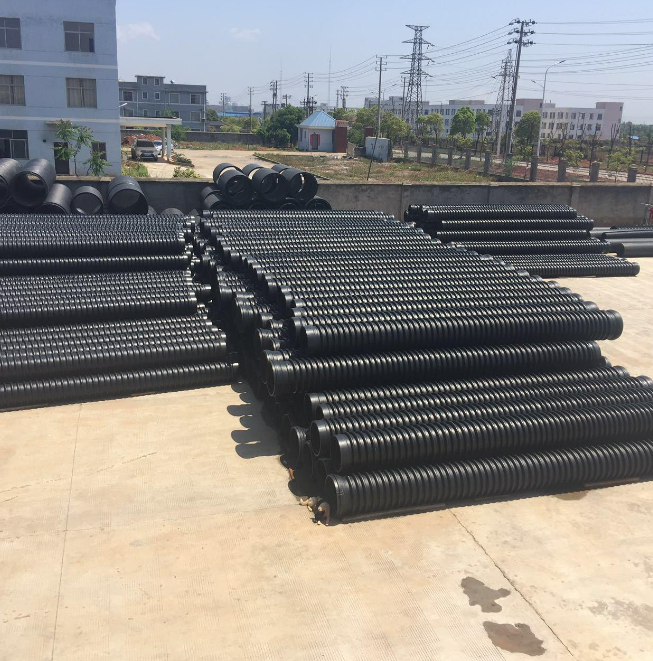1. Brief introduction of HDPE winding reinforced structural wall B tube (carat tube)
HDPE winding reinforced pipe (Type B), also known as HDPE winding structure wall pipe, carat pipe, HDPE winding B-type pipe, high-density polyethylene winding pipe, B-type structure wall pipe. It is a modern type of flexible pipe, with light weight, great strength, smooth inner wall, corrosion resistance, aging resistance, wear resistance, pressure resistance, strong impact resistance, excellent flexibility, health and safety. HDPE pipe fitting suppliers guarantee high weld quality, body connection, excellent connection quality, 100% no leakage, long service life, quick and simple construction, suitable temperature range ±70℃, etc.
High density polyethylene resin as the main raw material
◆ Adopt hot winding forming process to produce
◆ Product classification: The product can be divided into PR/SQ/VW and OPF
◆ Pipe diameter range: DN300-DN3500mm
◆ Comply with the national standard GB/T19472.2-2004 (Buried polyethylene (PE) structural wall piping system Part 2: polyethylene winding structural wall pipe); industry standard CJ/T165-2002 and PREN12376.

2, HDPE winding reinforced structural wall B type tube (Clarat tube) product classification
(I) Classification by pipe section shape:
(1) PR type -- external winding type, that is, the internal surface of the product is smooth, and the external is shaped reinforced structure; mainly used as a buried drainage pipe.
②, SQ type -- internal enhancement, that is, the internal and external surface of the product is smooth, and the internal is a special-shaped reinforced structure; it is mainly used to make containers or cellar Wells.
③ VW type - solid wall pipe, mainly used for tee, elbow, secondary processing forming pipe fittings.
(2) Classification according to the form of pipe connection port
Type A: One end of the pipe is a socket and the other end is a socket.
Type B: The two ends of the pipe are sockets.
Type C: Both ends of the pipe are flat
3, the advantages of HDPE winding reinforced structural wall B-type tube (carat tube):
◆ Superior quality of hot wound steel die forming weld;
◆ Electric fusion connection of socket, excellent connection quality, 100% no leakage;
◆ Extreme connection strength, multi pipe welding in the groove, the whole groove, saving time and labor;
◆ Complete system accessories, a variety of supporting pipe fittings, inspection Wells;
◆ Raw materials meet the requirements of national environmental protection, no pollution in the production process, can be recycled in all, belongs to green
◆ Environmental protection products;
◆ Excellent drainage flow performance: pipe wall smooth friction, quick flow rate, large flow;
◆ Corrosion resistance, aging resistance, long service life, to ensure more than 50 years;
◆ Excellent flexibility, improve the earthquake resistance and disaster reduction capability of public facilities;
◆ Use computers for product structure design, selection and strength calibration, quickly and accurately to provide users with engineering solutions and select the best products.
4. HDPE winding reinforced structural wall B-type tube (carat tube) connection process
High density polyethylene winding reinforced pipe with electric fusion connection socket is adopted. When the socket end is inserted into the socket end, the clamp is pressed outside the socket end, and the chain-copper resistance wire laid inside the socket end is connected with the electric fusion welding machine, and the electric heating is carried out, so that the socket and the socket in the electric fusion connection area are melted and welded together with the pipe material to realize the pipe connection. As shown below:
5, HDPE winding reinforced structural wall B type tube (klaat) application field
(1) Municipal water supply and drainage: Currently, the internal pressure of high-density polyethylene (HDPE) winding reinforced pipe can reach 12kg/cm2, which is the ideal pipe to replace the original cast iron pipe and cement pipe of urban drainage.
(2) Large-scale water conservancy projects: long-distance water transmission, farmland irrigation, reservoir pumping and silting.
(3) Petroleum industry: oil and gas pipelines.
(4) Coal industry: coal transport engineering, all kinds of ventilation systems.
(5) Chemical engineering: chemical containers, especially corrosive fluid transport pipelines.
(6) Environmental protection projects: deep sea sewage, sewage treatment, garbage dump sewage, detoxification pipeline.
(7) Power engineering: circulating water pipeline.
(8) Laying of pipelines in corrosive surroundings.
(9) Crossing culverts and pedestrian crossings with large traffic loads such as highways and railways.
(10) Others: such as deserts, swamps, lakes with fluid transport.